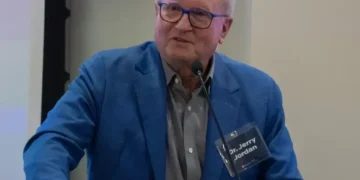After 10 seconds of silence, a room previously stricken with suspense erupted into applause and joyous tears.
Surrounded by students, community members and university police officers, the Ole Miss Associated Student Body Senate unanimously passed a resolution calling for the relocation of the Confederate statue from the Circle to the Confederate cemetery.

“This is not what I expected,” John Chappell, president of College Democrats and co-author of the resolution, said. “I didn’t think it was going to be unanimous, but this shows that the university, the student body as a whole, is sending a strong message that this statue does not represent us.”
ASB publicly released the resolution, authored by Chappell, Sen. Katie Dames, Sen. Jarvis Benson, Sen. Charlotte Armistead, Sen. Arielle Hudson, Leah Davis, Tyler Yarbrough and Sen. Dalton Hull, on Feb. 26. Since then, the Senate received 164 constituent comments regarding the possible statue relocation, of which 57.9 percent were favorable and 31.7 percent were unfavorable.
“This is a big moment, and it’s a big moment for African-American students especially,” said Benson, who is also the president of the Black Student Union. “Fifty years ago, we couldn’t be here. Twenty years ago, this definitely wouldn’t have passed. Five years ago, I don’t even think this would have passed.”
Benson said he was fearful coming into the vote, concerned that his fellow senators would not understand or feel as strongly about the need to move the Confederate statue to a more appropriate location than the heart of the Ole Miss campus.
“I just feel awesome that we made a right step in the direction of progress and a right step in making sure every student who steps on campus feels welcome and respected,” Benson said.
ASB President Elam Miller was present for the vote and has signed the legislation, moving it into the hands of university administration.
“We live in quite a divisive time these days, and I think tonight really shows great compromise,” Miller said. “We are making history.”
He also promised to follow through with this legislation by holding the university administration accountable to moving it forward in a timely manner.

“I think the next steps right now are setting up meetings, making sure the administration knows that this resolution passed, that they are hearing the student voice,” Miller said.
All of the authors said this resolution passed as a unified effort across student organizations and the Oxford community.
The uncontested passage of this resolution comes less than two weeks after neo-Confederate groups rallied around the statue in the Circle and the Confederate statue in the Square, protesting their removals.
Leah Davis, co-director of ASB’s committee for inclusion and cross-cultural engagement, insisted that this legislation is not a reaction to those events.
“It’s proactive, and it has been in the works for a while,” Davis said. “It just so happened, coincidentally, that the protests happened a couple of weeks ago.”
Dames is the chairperson of the committee for inclusion and cross-cultural engagement, which is where the resolution originated. She led the meetings and research that took place over the past several months before the drafting of the legislation.
“I know there have been lots of questions about whether we are trying to erase history, and that is simply not our goal,” Dames said. “Our goal is to move history to a place where it is contextually appropriate so that we can begin to have conversations without yelling at each other and (without) having this beacon of conflict in the center of our campus.”
During the research process, one of the main questions Dames sought to answer was why the Chancellor’s Advisory Committee on History and Context (CACHC) never considered moving the statue throughout the contextualization process.
Dames met with at least two former members of the CACHC, one of whom informed her that former Chancellor Jeffrey Vitter prohibited the committee from discussing the location of the Confederate statue.
However, the majority of the former members of the CACHC sent the Senate a letter in support of this resolution.
The statue was erected in 1906 by a local chapter of the United Daughters of the Confederacy to honor the Confederate soldiers from the entirety of Lafayette County. Dames said a common misconception is that the statue was put in place to honor a specific group that was composed mostly of University of Mississippi students, the University Greys.
“Over the past couple of weeks, there have been a lot of arguments and a lot of yelling and a lot of fear among the community and among our students,” Dames said. “What we hope to do by introducing this legislation is to create a conversation so that people will listen instead of yelling.”
While all senators voted in affirmation of the resolution, several also stood to speak in support.
Sen. J.R. Riojas spoke about the context of the statue relocation.
“Relocating the statue isn’t going to change what has happened in our history,” he said. “But we have a very rare opportunity right now. We have the opportunity to be on the right side of history.”

After similarly calling upon the idea of the group’s senatorial legacy, Sen. Barron Mayfield, who also serves as an Ole Miss Ambassador, said he avoids leading his tour groups directly past the statue.
“When we walk by it, people gawk, and they gasp,” Mayfield said. “It’s embarrassing. Why would we want anything that’s embarrassing, that turns people away, that makes people feel unwelcome on this campus?”
Many constituent comments suggested that ASB hold a referendum, or a student vote on the topic, but Dames said they deliberately chose to pass a resolution instead of turning the decision over to the students in order to comply with the authors’ understanding of Mississippi law, which allows for a “governing body” to decide upon relocation of the Confederate statue.
It is still unclear exactly what constitutes this “governing body,” but Chappell said the ASB Senate is part of the governing body of the Ole Miss campus because of the shared governance model of the university. The other groups who share governance are the Graduate Student Council, the Senate of the Faculty and the Staff Council.
The GSC Senate passed a resolution calling for the statue’s relocation on Monday night, and the Senate of the Faculty announced last night that it plans to vote on a similar resolution Thursday.





































